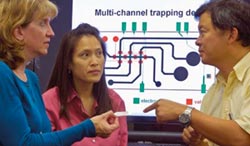
Integrated Nanosystems Research Facility
Science of Microfluidics
“Drop by Drop”
By Anna Lynn Spitzer | Interface Magazine
 Microtechnology and nanotechnology differ in scale, but nowhere do they converge as seamlessly as in the ultra-small channels on a microfluidic chip.
Microtechnology and nanotechnology differ in scale, but nowhere do they converge as seamlessly as in the ultra-small channels on a microfluidic chip.
Often referred to as a lab on a chip, microfluidics is the science of manipulating, mixing, metering and analyzing minute volumes – from microliters to picoliters – of fluid or gas on the surface of a chip. “It’s like taking a lab bench with beakers and mixers and all the other equipment, and shrinking it down,” says Gisela Lin, development manager at UCI’s Micro/Nano Fluidics Fundamentals Focus Center (MF3).
Founded in 2006 and funded by $12.5 million from DARPA and 10 corporate partners, MF3 unites 20
researchers from 12 universities with the goal of advancing microfluidic research and developing potential applications.
“In the past, everyone was just developing their own technologies, and there was not a lot of cooperation or collaboration,” Abe Lee, MF3 director, says. “Part of MF3’s function is to connect industry with academia.”
Today, the center works closely with local companies and with Lawrence Livermore National Laboratory and the NASA Ames Research Center.
“It’s a new way of thinking for microfluidics,” Lin says. “A lot of people understand it but they don’t actually do it, whereas at MF3, we’re actually trying to do it.”
Microfluidic chips are used to create biologic or chemical reactions at the micro- and nanoscale. But liquids and gases take on different properties at those scales. “At the microscale, water gets thicker and stickier,” Lin explains, and at the nanoscale it’s even more pronounced.
So creating the necessary reactions on a chip requires constructing devices that direct molecules towards each other in an efficient way. Pumps, valves and nozzles move the liquid or gas through the chip’s channels, forcing molecules to mix and react with each other. Those reactions produce results that can be quantified by electrical signals, color changes, weight changes or other indicators.
MF3 is focused on medical diagnostics – creating inexpensive, disposable, automated chips for testing blood, water and other fluids. By building the microfluidics on lowcost materials like plastic, paper and printed circuit boards, these point-ofcare diagnostics can be used easily in Third World countries or by the military. Additionally, chips created on printed circuit boards are ready to interface with cell phones or tablet computers, enabling field-based test results to be transmitted to doctors’ offices, military clinics or laboratories.
Lin foresees the strips being sterilized and packaged, similar to bandages, and readily available. Chips no larger than postage stamps might one day conduct multiple assays from a single drop of blood and could be manufactured for about one cent.
“If we didn’t have micro- and nanotechnologies, these chips would be the size of a desk,” she says.
Microfluidics also might unlock treatments for Alzheimer’s, Parkinson’s, multiple sclerosis and other neurodegenerative diseases.
Neurology assistant professor Lisa Flanagan is using microfluidic devices to try to determine the pathways used by neural stem cells as they become progenitor cells. These progenitors differentiate into three specific types: neurons, astrocytes and oligodendrocytes, each of which have precise functions in the brain and spinal cord.
In some illness or injury situations, the body needs astrocytes; in others, oligodendrocytes or neurons are the answer. Transplanting the differentiated cells themselves hasn’t worked; the mature cells end up dying. So scientists want to try transplanting progenitor cells and let them differentiate once they’re in the body.
But they can’t tell how the undifferentiated neural stem cells become progenitor cells that will produce what they want. The problem, says Flanagan, is a lack of identifying information. “We’re really behind [other fields] in terms of having markers to pull out the cells we’re interested in studying to understand more about their biology,” she says.
After much trial and error, she and Abe Lee found a way to evaluate the reaction of neural stem cells to an electric field on a microfluidic chip and separate the cells accordingly – a technique called dielectrophoresis.
“Our ultimate goal is to isolate these cells and then use traditional biological techniques to determine the differences between the progenitor cells,” she says. “We can start to understand the cells’ lineage tree. … and get a better handle on what kinds of cells are the right ones to transplant for certain kinds of diseases and injuries.”
Abe Lee sees the technology’s progress in the marketplace. “All the major diagnostic companies either have micro-fabbed components or microfluidic channels in their products already or they’re building these as we speak,” he says.
And the future? “Microfluidics hasn’t changed the world yet, but it’s changing it drop by drop.”



